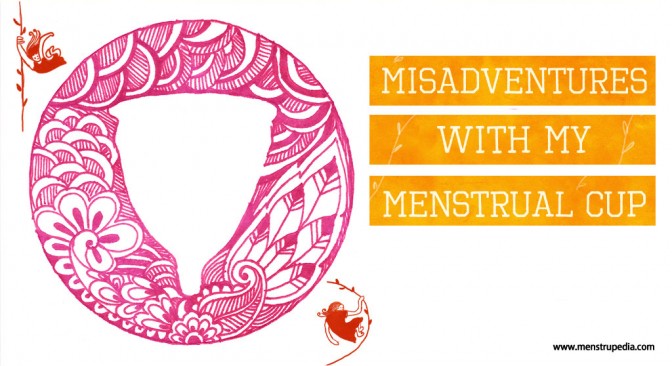One fine Monday evening, I came back from work, tra-la-la-ing about my latest acquisition. While friends my age were either saving up to buy an apartment, or browsing through scores of investment plansor having babies and booking tickets for a Euro trip, I was more than excited about this pink, shiny, globule of joy: a menstrual cup. Yes, it is exactly what it sounds like: A MENSTRUAL CUP. It is a cup-shaped object made from medical grade silicone that goes inside your vagina and simply collects all your period blood. From the outside, it looks like a hospital-pink version of something Jesus could have drank wine from as He broke bread during his passover meal. Oh and someone who is unaware of this could easily mistake it for *ahem* a sex toy.
[inlinetweet prefix=”” tweeter=”” suffix=””]”Oh, so it does not get lost inside?”[/inlinetweet] was what I naively asked my ex-roommate about tampons exactly a year earlier. She had rolled her eyes, pulled out two chairs, sat me down at the dining table while she grabbed two rough sheets from our growing stack and drew out the internal female anatomy. “THERE IS A CERVIX THERE. THE TAMPON CAN’T GET LOST INSIDE,” she had bawled. I wanted the earth to part right then and there and swallow me up whole.
At the same dining table, two months later, as we sat sleep-deprived, furiously typing away our 30,000-words-of-doom dissertation, we bumped into this miraculous little thing on the internet. We forgot about the word count for that night and read the inside-out (pun intended) of menstrual cups. Stoking our ‘we-are-so-uber-feminist’ ego, we promised to buy one for ourselves at the very earliest.
[inlinetweet prefix=”” tweeter=”” suffix=””]My first thought as I opened the airy, cotton bag it comes in was that there was no way that something THAT BIG could go inside.[/inlinetweet] The logical part of my brain kicked in and I reasoned that, well, a little human being complete with hands, legs and a big head can come out of my vagina. A one-finger long, flimsy-looking cup could most definitely find a home in there. With reason taking over apprehension, I turned on the music player in my room to the loudest volume and locked the door shut. I read the instruction manual that comes with it before trying to insert the menstrual cup. While it took a while for me to figure out the most comfortable position, as well as the angle in which it could be done best, the insertion itself took exactly 10 minutes even with my sister banging madly on the door. Lo and behold, the cup was now inside and I felt NOTHING of its presence. Elated, I did a little jig in my room and messaged my ex-roommate about my victory. After ten minutes of sashaying around, I decided it was time to call it quits. Two minutes later, I realized that the thing was stuck inside of me and refused to come out. As I found out much later,[inlinetweet prefix=”” tweeter=”” suffix=””] one doesn’t do a ‘dry run’ with a menstrual cup.[/inlinetweet] In other words, you don’t use it when you don’t have your period. There are mostly three reasons for this.
Firstly, the vagina is naturally lubricated when you are on your period; so insertion and removal is easy. Secondly, the cervix is much lower during your period, but is pretty high up otherwise; so if you do try a test run, chances are that the cup suctions itself to the cervix and makes it impossible to remove. Lastly, suction is easy to break when the cup is full.
Alas, I knew none of these on that night as I was trying to get the cup out intact. I was already imagining having to sleep that night with that thing INSIDE of me and running to the emergency room tomorrow. The worst part was to imagine having to explain this to a doctor on duty. Added to that was a friend who was least helpful and made fun of my high-on-humanities brain (“This is what happens when you don’t pay attention in Grade 7 Physics classes, hahahaha!”). The cup had suctioned itself to my cervix and breaking it was proving to be far too difficult. In desperation, I messaged my ex-roommate (“HALLLPPPPP!”) and she replied instantly with cheeky WhatsApp emoticons (“You have to birth that thing out. You have vaginal muscles for a reason…”). Armed with such expert advice and the will to prove my friend wrong, I[inlinetweet prefix=”” tweeter=”” suffix=””] was finally able to ‘give birth’ to a healthy, happy menstrual cup in the wee hours of the night.[/inlinetweet] I rinsed it and put it back in the cloth bag and flung it into the dark depths of my cupboard.
If one were to assume that I would never touch a cup after that ordeal, I did just the opposite. During my next period, I used the cup successfully, without it ever giving me trouble. Yes, it is slightly tricky, especially its insertion and removal. Once you master your way around it though, there is no looking back. Menstrual cups are manufactured by several companies like Lunette, Moon Cup, She Cup, V Cup, Silky Cup, and *insert any feminine-sounding name* Cup. They also come in different sizes and colours, with varying stem lengths and one can pick and choose from these permutations and combinations. Though the initial investment for a cup appears to be a lot (aShe Cup is priced at INR 700), one doesn’t have to invest in any other sanitary product for years to come. The biggest benefit of a menstrual cup is that it does not create any sanitary waste each month. There are no issues of disposal like one would have with sanitary pads/tampons. [inlinetweet prefix=”” tweeter=”” suffix=””]One can swim, get drenched in the rain and do every physical activity without having to worry about stains or leaks.[/inlinetweet] All one has to do is empty it out every 8-12 hours, rinse the cup and insert it back. At the end of each cycle, you simply have to boil it in water for 20 minutes on the stove. You also get to scandalize your mother in this process. The menstrual cup is safer than tampons because, one, it does not absorb all the moisture from the vagina, leaving its PH balance intact and two, it has a lesser risk of Toxic Shock Syndromes.
At the end of two cycles, I am now busy shooting mails and messages to friends, urging them to use it, especially if they don’t have issues with insertion. Yes, it feels funny and strange in the beginning, simply because it is a new feeling but once you get the hang of it, there is absolutely no looking back. If you are still unconvinced, trust me, once you start using it, you’ll get free, self-taught lessons in human anatomy each month! Happy exploring!
Sharmada, a reclusive writer and poet, was born in Bengaluru and spent a large part of her childhood reading obscure writers and disconsolate tales. She works with Pasand, a social enterprise in the areas of menstrual and reproductive health. You can drop her an e-mail at [email protected] or just message her on Facebook!
Editor: Divya Rosaline










